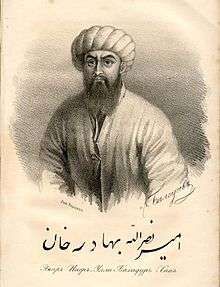Nasrullah Khan (Bukhara)
| Nasr-Allah bin Haydar Tora | |
|---|---|
 | |
| Emir of Bukhara | |
| Reign | 1827 – 1860 |
| Predecessor | Emir Haydar |
| Successor | Muzaffar al-Din bin Nasr-Allah |
| Born | 1806 |
| Died | 1860 |
| House | Manghud Dynasty |
| Father | Emir Haydar |
| Religion | Islam |
Nasrullah Khan or Nasr-Allah bin Haydar Tora was the Emir of Bukhara (1827–1860). His father was emir Haydar Tora (1800–1826). After Haydar's death Hussain bin Haydar Tora came to power. He died two months later and was succeeded by Umar bin Haydar Tora, who in 1827 was succeeded by Nasrullah.
Nasr-Allah bin Haydar Tora was ruler in a time when the Central Asian states were under pressure from the advance of Russian Empire to the north and the British Raj in the south. Nasr-Allah bin Haydar Tora is best known in the West as the Emir who imprisoned and eventually executed in 1842 the British envoys Charles Stoddart and Arthur Conolly, and imprisoned but eventually released Joseph Wolff who came in 1843 to seek news of them.
Emirate of Bukhara - Kokand Khanate Wars
Nasr-Allah bin Haydar Tora organized several unsuccessful military campaigns against the Kokand Khanate. In 1839 he declared war against Kokand due to their building of the Pishagar fort near the Bukhara front. He conquered Khojand twice in 1839 and 1841, forcing the Khan of Kokand into a peace in his favour and took Ura Tepe and Khojend as compensation. The Khan of Kokand was also forced to pay a heavy amount and recognize him as lord, putting his name on the coins and the khutba. After a revolt in Khujent the Emir's forces occupied Khojent and Kokand. Madali Khan, the Khan of Kokand escaped to Marghilan, but was captured and executed in Bukhara at the end of April 1842. Bukharan forces were in Khanate of Kokand were expelled after a revolt in Kokand two months later.
Nasr-Allah bin Haydar Tora died in 1860 and his son Muzaffar al-Din bin Nasr-Allah (1860–1885) came to power.
References
- Fitzroy Maclean: A Person from England and Other Travellers, 1958
- Fitzroy Maclean, Eastern Approaches, chap. 6 "Bokhara the Noble", 1949.
- Joseph Wolff: Narrative of a Mission to Bokhara, in the years 1843-1845, to ascertain the fate of Colonel Stoddart and Captain Conolly. London, J. W. Parker, 1845.